Black Soldier Fly larvae, aka Phoenix worms
#1
 Guest_fish for brains_*
Guest_fish for brains_*
Posted 28 February 2008 - 09:44 PM
I have a long and involved thread at a pond owner's forum, and if it isn't against the rules I would link to it as reference. The thread is many pages long with detailed descriptions and photos. I would never have the time to go into the same detail a second time, but I would be happy to pick up where I left off at the other thread.
PS. On a side note I would think that many others at the pond owner's forum would also enjoy posting here and visa versa. The membership includes fisheries biologists, pond building contractors, aquaculturists, and other seriously hardcore fish lovers. The two sites are different but very complimentary.
#2
 Guest_tglassburner_*
Guest_tglassburner_*
Posted 28 February 2008 - 10:23 PM
Please either post it here or pm me the link thanks.
I was just wondering if anyone was raising these amazing insects for fish food or for waste processing. I studied them quite a bit and successfully (easily) raised them. They are highly nutritious and fish love them.
I have a long and involved thread at a pond owner's forum, and if it isn't against the rules I would link to it as reference. The thread is many pages long with detailed descriptions and photos. I would never have the time to go into the same detail a second time, but I would be happy to pick up where I left off at the other thread.
PS. On a side note I would think that many others at the pond owner's forum would also enjoy posting here and visa versa. The membership includes fisheries biologists, pond building contractors, aquaculturists, and other seriously hardcore fish lovers. The two sites are different but very complimentary.
#3
 Guest_fish for brains_*
Guest_fish for brains_*
Posted 28 February 2008 - 10:38 PM
edit: I just edited the first post to replace some broken links.
Edited by fish for brains, 28 February 2008 - 11:17 PM.
#4
 Guest_critterguy_*
Guest_critterguy_*
Posted 01 March 2008 - 11:52 PM
How well would a closed system work? They seem to feed just as well on "clean" stuff. Could all stages be kept in a large sweater box and fed on vegetable scraps?
#5
 Guest_smilingfrog_*
Guest_smilingfrog_*
Posted 02 March 2008 - 05:32 AM
It might work. I don't think I would start off with veggie scraps though. If you are planning to order some fly larvae as a starter culture and allow them to mature, it might be possible to let them pupate, put the pupae in with some oatmeal or something dry that won't get moldy/smelly. It sounded like the final larval stage doesn't eat and remains in that stage for several weeks before pupating and I didn't see anything about how long they remain pupae so you'd want to check them everyday. I think the larvae crawl at that final stage to look for a dry place to pupate so you'd want to keep things dry till they emerge. Once they emerge, you might want to moisten the food slightly. It sounded like the lifespan of the adults is only a few days so once they emerge, they will be laying eggs right away and should all die off within a few days, assuming they all emerge at approximately the same time. All your larvae are then going to be roughly the same age. You will probably want several different "age groups" so that you'll always have some around of a given size. This could probably be accomplished by separating your larvae into several groups and refrigerating them for varying lengths of time. Depending on which size of larvae you want to use you may not want all stages in one container at the same time otherwise every time you open it the adults are going to fly away.Wow...fascinating.
How well would a closed system work? They seem to feed just as well on "clean" stuff. Could all stages be kept in a large sweater box and fed on vegetable scraps?
If you are only planning to use the final larval stage I suppose you could rig up some sort of tube system coming from the side of the container emptying into a sealed jar, since the last instar stage of the larvae will crawl off looking for a place to pupate, they'd fall into your jar, and you could harvest them that way. The occasional adult fly might find its way through the tube into the jar but most would stay in the box. You'd want to cut a small opening in the top of the box that you add veggie scraps through and stick an oversized sponge into the opening to seal it. that would minimize adult escapes if you do want all stages in the same box.
All this is pure speculation. If you try it make sure to let us all know how it works or doesnt.
Edited by smilingfrog, 02 March 2008 - 05:40 AM.
#6
 Guest_fish for brains_*
Guest_fish for brains_*
Posted 02 March 2008 - 09:21 AM
I wouldn't be concerned about promoting a wild population of BSF near my home because they are so non-invasive to humans. Most likely BSF are already living in your area, more so the farther south you live. You may not have noticed their presence which is exactly why they're no problem to work with.
Once I became familiar with them the occasional BSF sighting was a pleasant event. Mainly when I saw them it was at my BSF unit when they would come to lay their eggs. Often they would do it as I watched.
#7
 Guest_mrgrackle_*
Guest_mrgrackle_*
Posted 02 March 2008 - 04:25 PM
Since the trashcan wasn't built for producing bsf for fishfood there was no built in way to harvest the maggots. In a properly designed container you can get the bsf to self harvest themselves. When they are done in their maggot stage they leave the compost pile to pupate. Due to the way they're shaped they can climed 45 degree angled walls. So if you have a ramp in your composter you can get them to climb up it and drop into a bucket. My bsf escaped the trashcan and crawled under the nearest rock, board, bucket, anything... I'd just turn stuff over, collect them and feed them to my goldfish who absolutely loved them. They started to get pretty aggressive at feeding time.
Lets see.. what else... they dissappeared in the winter, but then again I also emptied those composters because I needed the compost. This year I'm going to build a composter built especially for bsf. There's a commercial one that looks pretty sweet (the biopod, it's in the link provided by someone above), but I can't see spending that much money on something I can build myself... if it's just a bucket tipped at a 45 degree angle with the mouth of it over the fish tank (self harvesting+feeding in one).
#8
 Guest_fish for brains_*
Guest_fish for brains_*
Posted 02 March 2008 - 07:47 PM
You can see that they have incorporated a collection bucket for the liquid.
I built my own unit out of necessity because there wasn't a commercial one available until recently. Of course cost is a factor, but if you can afford this product it will most likely perform better than what you can easily build. Part of the reason I encourage people who can afford this unit to buy it is because ESR, the company that developed this product is a very good company. You can read about the company here:
http://thebiopod.com/pages/about.html
The man that formed ESR is one of the few scientists who had the vision to see the possibilities for BSF. It's true that his company works to make a profit, but they have chosen to do it in ways that also benefit the environment.
#9
 Guest_critterguy_*
Guest_critterguy_*
Posted 02 March 2008 - 10:58 PM
I could see a small container of compost inside of a larger one with a tube leading to a collection cup from the small container. You could harvest what late stage larvae/pupae you wanted...then put the rest inside the big container to hatch into adults that would enter the small container to lay eggs.
#10
 Guest_fish for brains_*
Guest_fish for brains_*
Posted 03 March 2008 - 07:41 AM
I'm not trying to dissuade you from creating a closed BSF environment, just sharing some impressions about BSF. After handling them almost daily for many months last year I got the feeling that they are a fairly clean animal.
Have you considered a split system? I'm thinking you could maintain a scrap pile outdoors where you could collect eggs on clean cardboard and then transfer it to an indoor BSF hatchery. If you suspend cardboard above a scrap pile the adults will often lay eggs there. Their typical behavior is to lay eggs above and not on the food source. I've read that if you treat the cardboard with the liquid that collects in a BSF pile you will attract more adults looking to lay eggs. Maybe you could sterilize the liquid, or only saturate one corner of the cardboard which you could remove later. I can attest to the fact that female BSF are attracted to the scent. After working with the larvae for several months I got less "clinical" in the way I would handle them. In other words I would stick my hands into the pile a little sometimes and not run to a sink to wash immediately.

(Dr. Jeff Tomberlin)
Anyway, after handling the larvae, and getting the scent on me, I noticed that I got more popular with the ladies (BSF ladies). They would sometimes come by and flirt a little. I don't recall them actually landing on me, but if they did it wouldn't have been any different to me than if a butterfly landed on me. Btw, the scent is earthy but pleasant.
#11
 Guest_scottefontay_*
Guest_scottefontay_*
Posted 03 March 2008 - 10:22 AM
#12
 Guest_fish for brains_*
Guest_fish for brains_*
Posted 03 March 2008 - 11:18 AM
Since I was most active on a pond owner's forum while raising the BSFL, I focused on benefits that they could relate to. Something all pond owners eventually face is having to dispose of dead fish, whether they are accidental morts or culls. Most people toss the dead fish onto the bank and let the local wildlife eat them. While that's nice for the animals, I like the idea of returning that protein to the pond in the form of BSFL. I tested my BSF unit with a 4 oz Redear to see how long it would take to process and see about any bad odor. It was roughly 90 degrees when I did the test and the smell was barely noticeable. When the lid was on the container an average person could stand within a few feet of it and not notice the smell. With the lid off the odor was noticeable but faint.
The larvae that could be observed on the fish at any one time only represented a small fraction of the total population at that point. I think it's safe to assume that 2 or 3 additional fish could have been processed at the same time with similar results. I made a 1 inch cut into the belly of the fish, but after watching the BSFL work I don't think it would have slowed them down much if I hadn't.
9:15 am
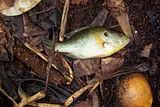
11:30 am
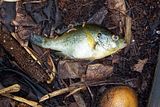
1:50 pm
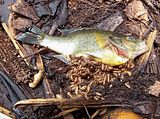
3:30 pm
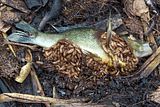
5:00 pm
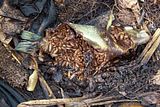
6:00 pm
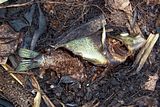
7:00 pm

8:00 pm
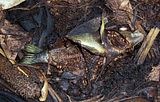
Next day 7:30 pm
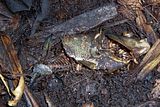
Within 48 hours there was no obvious sign that the fish was ever there.
#13
 Guest_critterguy_*
Guest_critterguy_*
Posted 03 March 2008 - 09:48 PM
#14
 Guest_fish for brains_*
Guest_fish for brains_*
Posted 03 March 2008 - 09:59 PM
Is their any problem with getting BSF to mate in a closed system? I am tempted to do both an open system for my pond/fish and a closed system for some indoor captives.
I don't have a clue critterguy, but with only a few days to mate before dying I'd guess that the drive is pretty strong. I can tell you that they usually mate on bushes.
#15
 Guest_critterguy_*
Guest_critterguy_*
Posted 03 March 2008 - 10:03 PM
I
suspect that whoever grows the phoenix worms uses a indoor system. I've done some reading that suggets at least some flight is involved in courtship.
Edited by critterguy, 03 March 2008 - 10:34 PM.
#16
 Guest_fish for brains_*
Guest_fish for brains_*
Posted 03 March 2008 - 11:13 PM
#17
 Guest_rolivier79_*
Guest_rolivier79_*
Posted 04 March 2008 - 03:36 AM
Is their any problem with getting BSF to mate in a closed system? I am tempted to do both an open system for my pond/fish and a closed system for some indoor captives.
Hello Criter Guy,
To answer your question, my father who started the initial research on the black soldier fly (http://thebiopod.com/pages/about.html and http://www.esrint.co...onversion.html) back in the late 1990's tried excessivly to raise them in captivity. However we never succeeded in getthing them to mate under artificial light conditions. For some reason they refuse to mate indoors. Now the moment we put them in a fully natural light green house mating would return and we could create a semi-closed environment. But why go through the expense of a greenhouse if you really don't need it. At least in texas you don't. Shade is actually more important hear, than heat.
I hope this helps you out.
#18
 Guest_fish for brains_*
Guest_fish for brains_*
#19
 Guest_critterguy_*
Guest_critterguy_*
Posted 04 March 2008 - 03:45 PM
Hello Criter Guy,
To answer your question, my father who started the initial research on the black soldier fly (http://thebiopod.com/pages/about.html and http://www.esrint.co...onversion.html) back in the late 1990's tried excessivly to raise them in captivity. However we never succeeded in getthing them to mate under artificial light conditions. For some reason they refuse to mate indoors. Now the moment we put them in a fully natural light green house mating would return and we could create a semi-closed environment. But why go through the expense of a greenhouse if you really don't need it. At least in texas you don't. Shade is actually more important hear, than heat.
I hope this helps you out.
Hello rolivier.
Thanks for the info! Hmmm...would window light work? Or does it need to be overhead.
#20
 Guest_rolivier79_*
Guest_rolivier79_*
Posted 04 March 2008 - 04:51 PM
Please enjoy: Rearing Methods for the Black Soldier Fly - Department of Entomology, University of Georgia, Tifton 2002. This research study discusses the creation of an artificial setting where mating, egg laying, and rearing of larvae can occur year round in a control environment. Maintenance of a continual black solider fly colony will allow for development and implementation of advanced waste management technologies. Sheppard, Tomberlin, Joyce, Kiser, Sumner
Link:
http://www.thebiopod.../colony2002.pdf
Robert
Hello rolivier.
Thanks for the info! Hmmm...would window light work? Or does it need to be overhead.
1 user(s) are reading this topic
0 members, 1 guests, 0 anonymous users








